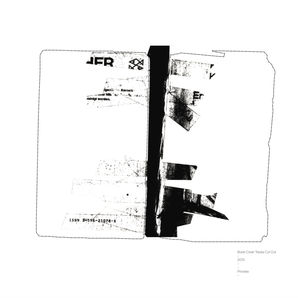ENTER VOID

Enter Void engages with a personal history of an unreturned library book, Sämtliche Erzählungen, by Franz Kafka and unfolds a narrative that is ‘directed’ and ‘animated’ by me to capture a moment where the private and social overlap. The book was originally taken out of a library in Berlin in 2002; however, when trying to return the book in 2005 I found that all traces of the library had been obliterated by a shopping center. While this project concentrates on ‘returning’ the book it simultaneously ‘unwraps’ a story of past events.
1. Das Buch
The process of the book starts with the book cover, by looking at its marks and traces. It illustrates a ‘Horse & Rider’ drawn by Franz Kafka in 1909 and Fischer Taschenbuch Verlag logo drawn as continuous line forming three fish. Traces of tapes hold the struggling book pages in place prolonging the process of the book’s decay. The discoloured tape indicates an abstract timescale and creates a relation to its physicality in reference to the library. Using these traces, which consist of tape marks, notes and creases I began responding to them by creating a two and a half dimensional drawing.
This drawing can be viewed and explored in different ways but also depicts the depth between the traces and the book itself. I am allowing the object, the book, to reveal its surfaces and take form of site specific relations drawn as lines, cutting into one another, by slicing, parting, recomposing and eventually creating a new sectional condition of the book. The outcome of this intersectional process of recomposing traces and surfaces from the book cover is that it awakes old data and creates new ways of analysing and perceiving this information.
The traces marked on the book cover are indicating moments of past interactions with previous readers and therefore are a direct intersection with the library.



2. Library
The practice of Enter Void applies parameters to deploy a process of reconstruction by mapping a space of nonexistence. These parameters are ‘dictated’ by a book that generates a narrative and navigates the preconceived information and memories.
The book that navigates the ‘reconstructive’ process is a book by Franz Kafka that once used to belong to a library in Berlin, Steglitz, which is a place that no longer exists. The narrative begins with me, the narrator, taking the book out of the library and failing to return it. However this story only awakes its discourse when the narrator (myself) wants to return the book and finds a shopping center in its place.The book’s displacement forces the ‘narrator’s’ interiority to revisit the preconceived library space by projecting oneself within a past experience, in this case a cumulative memory of events, rejecting the present reality of the shopping center, provoking the yearning for the book’s place of origin and trigger a ‘fantasy’. In this case, that means not only focusing on the bookshelf within the library, but also the narrative of the book itself intersecting with the narrative of the library.

3. Intersect I
So how can I work from an unavoidable present through memories of past events?
The process of remembering is a simultaneous act of expansion and reduction taking place. The first act of remembering is the expansion; bringing oneself into the realm of the ‘pure past’ in which all past events coexist in reference to the present. One enters an intersection of all times past, as Stewart describes as the primary mode of perceiving scale in her book On Longing. The second act would be a movement through a specific event one wants to recall. In Enter Void I describe this recall of the past in reference to the present, through an action of compressing these different events or timeframes into drawings that are mapping the entirety of the past. History remains and is present in a condensed form and positioned towards a specific event.



4. Intersect II
My analytical approach towards the site, which consists of the shopping center and the house Kafka lived in, was by mapping out past events and creating an environment of ‘connective-ness’, where elements from different timelines intersect with each other. A multiplicity of moments are overlaid for the drawing to gain a ‘thickness’ of information as it is reaches a condensed layer in the form of a map, using lines to notate the social and historical events of the book and library in reference to the present condition. The drawings make these events become a visible space and act as a release from physical restriction. The ‘structure’ of the site has changed and only exists within the narrative that is integrated within the drawing process, therefore meaning that the site scale has expanded through additional narrative layers and is no longer fixed to its location. However, through this process of recalling past experiences a new experience in reference to the old one is created; Another layer is added to the narrative and therefore creates an interconnection of events with no defined outcome, similar to Kafka’s book ‘Das Schloss’.
So how can I work from an unavoidable present through memories of past events?
The process of remembering is a simultaneous act of expansion and reduction taking place. The first act of remembering is the expansion; bringing oneself into the realm of the ‘pure past’ in which all past events coexist in reference to the present. One enters an intersection of all times past, as Stewart describes as the primary mode of perceiving scale in her book On Longing. The second act would be a movement through a specific event one wants to recall. In Enter Void I describe this recall of the past in reference to the present, through an action of compressing these different events or timeframes into drawings that are mapping the entirety of the past. History remains and is present in a condensed form and positioned towards a specific event.

5. Materials

6. Installation


































































